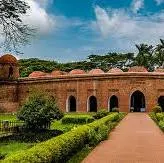Heritage passage Bangla meaning 1st paper
‘Heritage’ is what we inherent from the past, live with them in the present and then pass on to our children or future generation. Our unique source of life and inspiration is our culture and natural heritage. When we speak of world ‘heritage’ it indicates places and sites that we got from the past and pass on the future generation of the entire world.
The ‘shat Gombuj Mosque’ in Bagehot is such place. It becomes a UNESCO World Heritage site in 1985.Originally, the historic Mosque city was known as ‘Khalifatabad’. It is situated at the outskirts of Bagehot town-not very far from the dense mangrove forest of the Sundarbans. Khalifatabad was a Muslim colony. It was founded by the Turkish general, a saint warrior Ulugh khan Johan in the 15th century.
The infrastructure of the city revels significant technical skill in many mosque as well as early Islamic monument. Baked bricks were used for the construction of buildings.
The planning of the city was distinctly dominated by Islamic architecture and decoration were combination of Mughal and Turkish architecture Khan Johan built a network of roads, buildings bridges, public buildings and reservoirs to make the city habitable. There are about 360 mosques in the city.
Among them, the most remarkable is the multi-domed Shat Gombuj mosque. The mosque is unique in the sense that it has 66 pillars that support the roofs, with 77 low-height domes. The thickness of the arches is 6 feet and have slightly narrowing hallow and round wall. The west wall in the interior has 11 ‘mihrabs’ (niche in mosque pointing toward Makkah).
These Mihrabs are decorated with stonework and terracotta. The floor of the mosque is made of brick,. Besides being used as prayer hall, Khan Jahan used the mosque as his court too. Today, it is one of the greatest tourist attractions and one of the best architectural beauties of Bangladesh.
Heritage passage bangla meaning
অনুবাদ: হেরিটেজ' হল যা আমরা অতীত থেকে অন্তর্নিহিত, বর্তমানের সাথে তাদের সাথে বসবাস করি এবং তারপরে আমাদের শিশুদের বা ভবিষ্যত প্রজন্মের কাছে প্রেরণ করি। আমাদের জীবন ও অনুপ্রেরণার অনন্য উৎস হল আমাদের সংস্কৃতি ও প্রাকৃতিক ঐতিহ্য। আমরা যখন বিশ্ব ‘ঐতিহ্য’-এর কথা বলি, তখন তা নির্দেশ করে সেই স্থান ও সাইটগুলি যা আমরা অতীত থেকে পেয়েছি এবং সমগ্র বিশ্বের ভবিষ্যৎ প্রজন্মের কাছে পৌঁছে দিয়েছি।
বাগেহোটের 'শত গম্বুজ মসজিদ' এমনই একটি জায়গা। এটি 1985 সালে ইউনেস্কোর বিশ্ব ঐতিহ্যবাহী স্থান হয়ে ওঠে। মূলত, ঐতিহাসিক মসজিদ শহরটি 'খলিফাতাবাদ' নামে পরিচিত ছিল। এটি বাগেহট শহরের উপকণ্ঠে অবস্থিত - সুন্দরবনের ঘন ম্যানগ্রোভ বন থেকে খুব বেশি দূরে নয়। খলিফাতাবাদ ছিল একটি মুসলিম উপনিবেশ। এটি ১৫ শতকে তুর্কি জেনারেল, একজন সাধু যোদ্ধা উলুগ খান জোহান দ্বারা প্রতিষ্ঠিত হয়েছিল।
শহরের অবকাঠামো অনেক মসজিদের পাশাপাশি প্রাথমিক ইসলামিক স্মৃতিস্তম্ভে উল্লেখযোগ্য প্রযুক্তিগত দক্ষতা প্রকাশ করে। ভবন নির্মাণের জন্য বেকড ইট ব্যবহার করা হত। শহরের পরিকল্পনায় সুস্পষ্টভাবে ইসলামিক স্থাপত্যের প্রাধান্য ছিল এবং সাজসজ্জা ছিল মোগল এবং তুর্কি স্থাপত্যের সংমিশ্রণে খান জোহান শহরটিকে বাসযোগ্য করার জন্য রাস্তা, বিল্ডিং ব্রিজ, পাবলিক ইমারত এবং জলাধারের একটি নেটওয়ার্ক তৈরি করেছিলেন। শহরটিতে প্রায় ৩৬০ টি মসজিদ রয়েছে।
তার মধ্যে সবচেয়ে উল্লেখযোগ্য হল বহু গম্বুজ বিশিষ্ট ষাট গম্বুজ মসজিদ। মসজিদটি এই অর্থে অনন্য যে এর ৬৬ টি স্তম্ভ রয়েছে যা ছাদকে সমর্থন করে, ৭৭ টি কম উচ্চতার গম্বুজ রয়েছে। খিলানগুলির পুরুত্ব ৬ ফুট এবং সামান্য সংকীর্ণ হললো এবং গোলাকার প্রাচীর রয়েছে। অভ্যন্তরের পশ্চিম দেয়ালে ১১ টি ‘মাহরাব’ (“মাহরাব” যা মসজিদের মক্কার দিকে নির্দেশ করে) রয়েছে।
এই মিহরাবগুলি পাথরের কাজ এবং পোড়ামাটির দ্বারা সজ্জিত। মসজিদের মেঝে ইট দিয়ে তৈরি। নামাজের ঘর হিসেবে ব্যবহৃত হওয়ার পাশাপাশি খান জাহান মসজিদটিকে তার দরবার হিসেবেও ব্যবহার করতেন। আজ, এটি বাংলাদেশের অন্যতম সেরা পর্যটকদের আকর্ষণ এবং অন্যতম সেরা স্থাপত্য সৌন্দর্যের একটি।
Choose the best answer from the alternatives.
i) Muslims✓ ii) Hindus iii) Buddhists iv) Christians
2. Shat Gambuj Mosque got the status of a world heritage site from ---.
i) 1980 ii) 1985✓ iii) 1982 iv) 1984
i) 1980 ii) 1985✓ iii) 1982 iv) 1984
3. The mosque is situated in ---.
i) Bogra ii) Magura iii) Bagerhat✓ iv) Barisal
i) Bogra ii) Magura iii) Bagerhat✓ iv) Barisal
4. The surface of the mosque is of ----.
i) wood ii) stage iii) brick✓ iv) iron
i) wood ii) stage iii) brick✓ iv) iron
5. Khan Jahan built the mosque in the ---- century.
i) 15th✓ ii) 16th iii) 17th iv) 14th
i) 15th✓ ii) 16th iii) 17th iv) 14th
6. The mosque was established by a person who was ---.
i) Turkish✓ ii) British iii) Arabian iv) Bangladeshi
i) Turkish✓ ii) British iii) Arabian iv) Bangladeshi
7. The mosque has --- pillars.
i) 50 ii) 40 iii) 30 iv) 60✓
8. There are almost ---- mosques in the city.
i) 350 ii) 360✓ iii) 370 iv) 380
i) 50 ii) 40 iii) 30 iv) 60✓
8. There are almost ---- mosques in the city.
i) 350 ii) 360✓ iii) 370 iv) 380
9. The --- was decorated.
i) west wall✓ ii) arches iii) domes iv) roof
i) west wall✓ ii) arches iii) domes iv) roof
10. The thickness of the arches is --- feet.
i) less than 6 ii. more than 6 iii) exactly 6✓ iv. about 6
i) less than 6 ii. more than 6 iii) exactly 6✓ iv. about 6
11. Shat Gambuj Mosque became a world heritage site in ——.
(i) 1958 (ii) 1985✓ (iii) 1858 (iv) 1885
(i) 1958 (ii) 1985✓ (iii) 1858 (iv) 1885
12. The floor of the mosque is made of ——.
(i) wood (ii) brick✓ (iii) stone (iv) soil
(i) wood (ii) brick✓ (iii) stone (iv) soil
13. Khan Jahan built the mosque in the ——.
(i) 15th century✓ (ii) 16th century (iii) 25th century (iv) 14th century
14. Shat Gambuj Mosque is situated ——.
(i) in Bogra (ii) at Mohammadpur, Dhaka
(iii) in Bagerhat✓ (iv) in Barisal
(i) in Bogra (ii) at Mohammadpur, Dhaka
(iii) in Bagerhat✓ (iv) in Barisal
15. Khalifatabad was a —— colony.
(i) Hindu (ii) Christian (iii) Buddhist (iv) Muslim✓
(i) Hindu (ii) Christian (iii) Buddhist (iv) Muslim✓
16. 'Heritage' is what we inherit from the—.
(i) past✓ (ii) present (iii) future (iv) long ago
(i) past✓ (ii) present (iii) future (iv) long ago
17. The 'Shat Gambuj Mosque' is at the outskirts of—.
(i) Mirpur (ii) Bagerhat✓ (iii) Sundarbans (iv) Tongi
(i) Mirpur (ii) Bagerhat✓ (iii) Sundarbans (iv) Tongi
Answer the following questions
a. What is heritage?
Answer: Heritage is what we inherit from the past, live with them in the present and then pass on to our future generation.
b. What is the floor of the mosque made of?
Answer: The floor of the mosque is made of brick.
c. When did the mosque become a world heritage site?
Answer: The mosque became a world heritage site in 1985.
d. How many mosques are there in the city?
Answer: There are about 360 mosques in the city.
e. Who built the Shat Gambuj Mosque?
Answer: The Turkish general, a saint warrior, Ulugh Khan Jahan built the Shat Gambuj Mosque.
f. What does the infrastructure of the city reveal?
Answer: The infrastructure of the city reveals significant technical skills in many mosques as well as early Islamic monuments.
Answer: The Turkish general, a saint warrior, Ulugh Khan Jahan built the Shat Gambuj Mosque.
f. What does the infrastructure of the city reveal?
Answer: The infrastructure of the city reveals significant technical skills in many mosques as well as early Islamic monuments.
g. Where is Khalifatabad situated?
Answer: Khalifatabad is situated at the outskirts of Bagerhat town not far from the Sundarbans.
h. What is “World Heritage”?
Answer: “World Heritage” indicated places and sites that we got from the past and pass on to the future generations of the entire world.
i. What do you know about Khalifatabad?
Answer: The historic mosque city was originally known as Khalifatabad.
j. What did Khan Jahan build to make the city habitable?
Answer: Khan Jahan built a network of roads, bridges, public buildings and reservoirs to make the city habitable.
k. Who did build the Shat Gambuj Mosque?
Answer: The Turkish general a saint warrior Ulugh Khan Jahan built the Shat Gambuj mosque.



